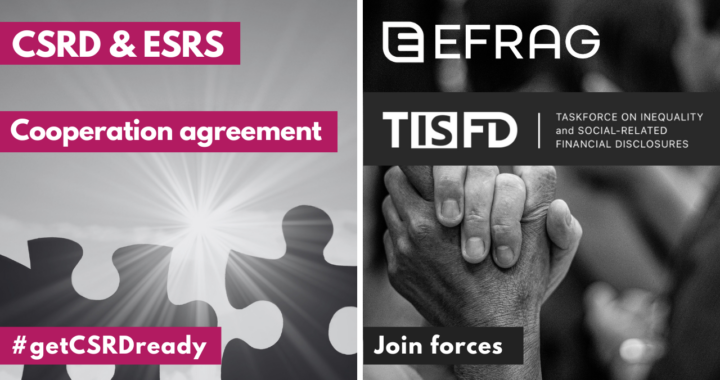On September 27 the Taskforce on Inequality and Social-related Financial Disclosures (TISFD) communicated its official launch, and on the same day EFRAG and TISFD announced that it had signed a cooperation agreement.
The collaboration seeks to promote global disclosure frameworks that enable businesses and financial institutions to understand and report on their impacts, dependencies, risks, and opportunities related to people.
It reflects EFRAG’s and TISFD’s shared commitment to enhancing corporate transparency on social issues and supporting companies in meeting growing stakeholder expectations for more equitable and sustainable business practices.
By aligning efforts, EFRAG and TISFD will work together, building on each organisation’s unique expertise in sustainability and corporate reporting.
Key objectives of the agreement include:
- Technical alignment ensuring consistency between EFRAG’s EU Sustainability Reporting Standards, ESRS, and TISFD’s global framework.
- Co-developed implementation support to assist companies in disclosing inequality and social-related data, facilitating the adoption of ESRS and TISFD requirements.
TISFD is a global initiative to develop recommendations and guidance for businesses and financial institutions, with the aim to incentivize business and financial practices that create fairer, stronger societies and economies.
The initiative is supported by financial institutions, business, civil society, and labour leaders worldwide, including UN Development Programme, OECD, ILO, OXFAM, WBC and PRI.
You may have heard about the Task Force on Climate-Related Financial Disclosures (TCFD) – now disbanded as the work has been completed and the recommendations incorporated into both the ISSB and ESRS standards.
The TCFD was set up by the Financial Stability Board in 2015 following a request from the G20 to improve and increase reporting of climate-related financial information, to support investors and other financial actors in appropriately assessing and pricing a specific set of risks – risks related to climate change – to avoid misallocation of capital.
Then came the Taskforce on Nature-related Financial Disclosures (TNFD) in 2023 – a set of disclosure recommendations and guidance for organisations to report and act on evolving nature-related dependencies, impacts, risks and opportunities. The more holistic idea is that TNFD biodiversity and nature-loss data will complement companies’ existing climate disclosures.
And now we have the TISFD to add the S to the ESG equation.
Anyone still thinks sustainability has nothing to do with financial performance?
Sources:
https://www.fsb-tcfd.org/about/
#getCSRDready, #CSRD, #ESRS, #CSDDD, #ESG, #Strategy, #Governance, #SustainabilityReporting, #Digitalisation, #CleeritESG


